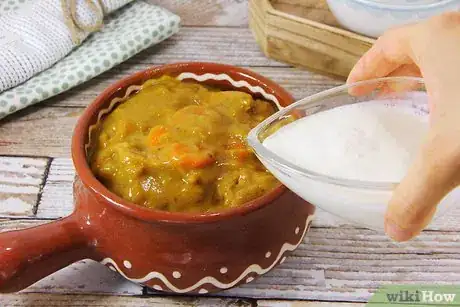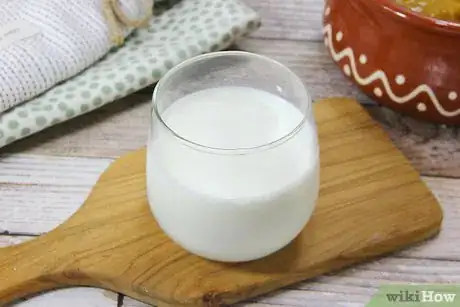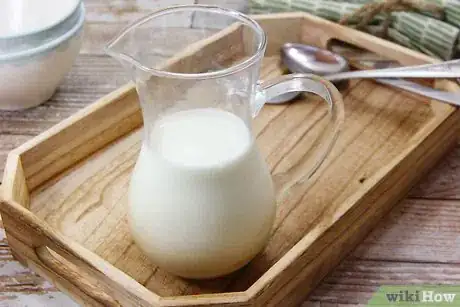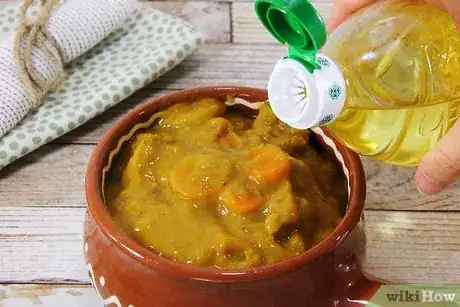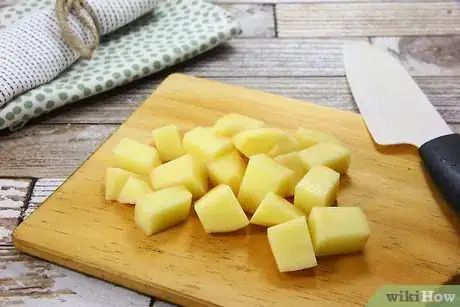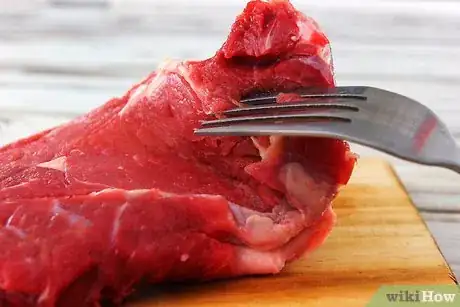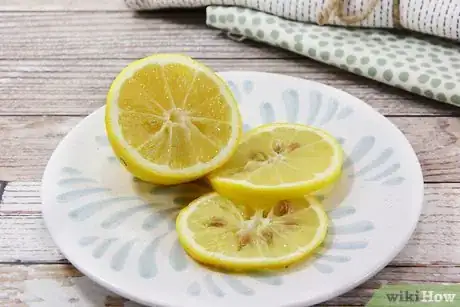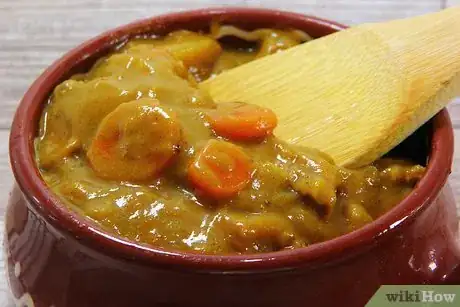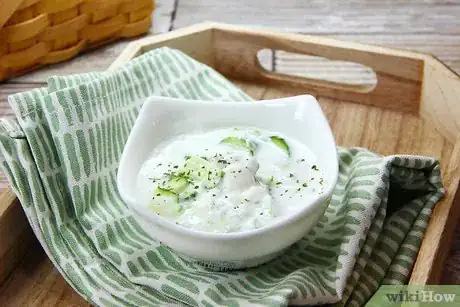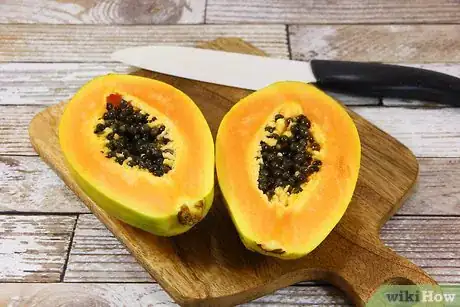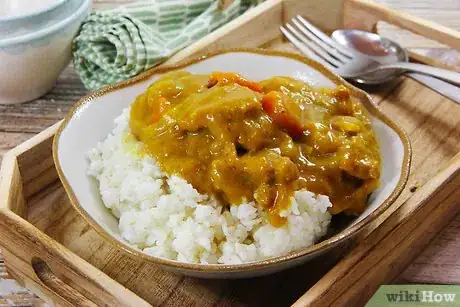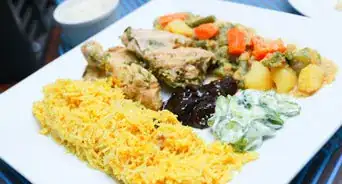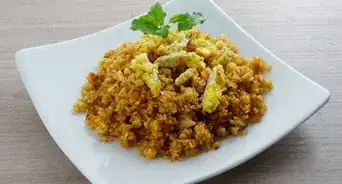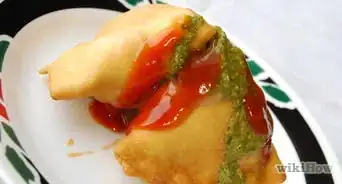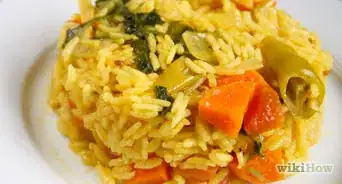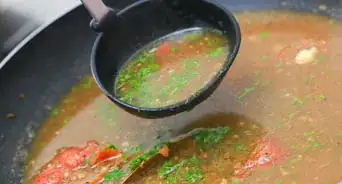This article was co-authored by Jillian Fae Downing. Jillian Fae Downing is a Private Event Chef, Chef Educator, and the Owner of Jillian Fae Chef Services based out of Temecula, California. With 12 years of experience, she specializes in menu planning and menu research and development. Jillian Fae holds an Associate of Science in Culinary Arts from Orange Coast College and a BA in Mass Communication and Media Studies from Arizona State University. She is also a member of the American Culinary Federation and the American Personal and Private Chef Association.
There are 9 references cited in this article, which can be found at the bottom of the page.
This article has been viewed 114,240 times.
Don't worry that all of your ingredients and hard work have gone to waste if you make a curry that is too spicy! The spiciness of curries can easily be reduced using simple ingredients, depending on what you have available in your kitchen. Try adding dairy, coconut milk, or extra oil to the curry to tone down the spiciness. Alternatively, you can add more base ingredients, such as meat or vegetables, to help spread the spiciness out. When serving the curry, cucumber raita or fresh papaya are great cooling ingredients, and serving the curry with grains such as rice can also help to reduce the heat.
Steps
Using Dairy, Coconut, or Oil
-
1Add sour cream or yogurt if you don't mind thickening the curry. Place 1 US tbsp (15 ml) of sour cream or yogurt into the pot of curry. Mix it in with a wooden spoon. Taste the curry to see if the spiciness has been reduced.[1]
- If the curry is still too spicy, continue adding a spoonful of either ingredient and tasting it to see if it improves the flavor.
- Be careful not to add too much sour cream or yogurt, as this may make the consistency of the curry too thick.
-
2Use coconut milk if it matches the flavor. Many curries have a coconut base, which means that adding coconut milk can work perfectly to dial down the heat. Add 1 US tbsp (15 ml) of coconut milk to the curry sauce, and taste it to see if it has helped.[2]
- Simply add another spoonful or two if the first wasn't enough, and keep tasting the curry to see if the flavor has improved.
Advertisement -
3Add milk if you don't mind thinning the curry. Milk can also help to tone down the spiciness of curry. Pour 1 US tbsp (15 ml) of milk into the pot that has the curry sauce in it, and mix it in to combine it with the other ingredients.[3]
-
4Use extra oil if the recipe already includes oil. Use either an oil that tastes neutral, such as vegetable oil, or one that will complement the flavors in the dish. Only add 1 teaspoon (4.9 mL) of oil at a time, and mix it in thoroughly.[7]
- Always try the curry before adding more oil to see how it has changed the taste.
Adding More Base Ingredients
-
1Add a handful of grated carrot or diced potatoes to absorb some spice. Place raw carrot or potato into the pot to cook with the curry sauce. Simmer the vegetables in the sauce for approximately 15 minutes, or until they are tender.[8]
- The vegetables that you use don't have to be those that you originally used in the dish.
-
2Use extra meat to reduce the spiciness if you want to bulk up the curry. The meat that is simmered with the curry will already be helping to take some of the edge off the spice. Use an extra quarter of the amount of meat, and cook it until it is lightly browned and tender, before adding it to the curry.[9]
- Adding extra meat works in a similar way to adding extra vegetables, as this will help to diffuse the flavors over a larger amount of ingredients.
-
3Add more acidic ingredients if they are already part of the dish. If you have already used lemon or lime juice, vinegar, tomatoes, or pineapple in the curry, then you can simply add more to help neutralize the dish. Add the juice of half a lemon or a lime, 1–2 tablespoons (15–30 mL) of vinegar or tomato sauce, or ¼ cup (50 g) of fresh tomatoes or pineapple to the curry, and see if the spiciness is reduced.[10]
- Taste the curry after each addition to check how spicy it is before adding more ingredients.
- Mix the extra ingredients in thoroughly to when you add them to help them properly combine.
-
4Make a double batch without doubling the spice to help diffuse the heat. If you have extra ingredients available and don't mind making more food, follow your original recipe and omit the ingredient that is making it too spicy. Combine the 2 curries at the end.[11]
- This will help to diffuse the heat through the end result dish, which means that the curry will be only half as spicy as it was originally.
Cooling the Curry When Serving
-
1Make a cucumber raita as a cooling condiment to serve with the curry. Raita is a cool and fresh condiment that you can eat with curry to take some of the heat off. Simply combine cucumber, plain yogurt, cilantro, green onions, coriander, and cumin to make this refreshing dish.[12]
- When it comes to serving the meal, just add a spoonful of cucumber raitha alongside the curry.
-
2Eat the curry with papaya to help cool it down. Pieces of fresh, green papaya go well with many coconut-based curries. Remove the papaya skin, scoop out the seeds, and shred the flesh using either a papaya peeler or a mandoline.[13]
- You can also add a garnish of fresh herbs such as mint to the papaya, as this will help to cool the curry down further.
-
3Serve the curry over rice to help absorb the spiciness. Although eating curry with rice is already a popular favorite, if you haven't tried it with the curry yet this could be a simple way to reduce the heat. Try jasmine, basmati, white, or brown rice as a base for the curry, and see if it helps to dilute the flavor.[14]
- Alternatively, other bland and starchy foods will have the same effect as rice. Try serving the curry with bread, quinoa, or potatoes to experiment with different flavors.[15]
Expert Q&A
-
QuestionHow do I tone down spicy food?
 Jillian Fae DowningJillian Fae Downing is a Private Event Chef, Chef Educator, and the Owner of Jillian Fae Chef Services based out of Temecula, California. With 12 years of experience, she specializes in menu planning and menu research and development. Jillian Fae holds an Associate of Science in Culinary Arts from Orange Coast College and a BA in Mass Communication and Media Studies from Arizona State University. She is also a member of the American Culinary Federation and the American Personal and Private Chef Association.
Jillian Fae DowningJillian Fae Downing is a Private Event Chef, Chef Educator, and the Owner of Jillian Fae Chef Services based out of Temecula, California. With 12 years of experience, she specializes in menu planning and menu research and development. Jillian Fae holds an Associate of Science in Culinary Arts from Orange Coast College and a BA in Mass Communication and Media Studies from Arizona State University. She is also a member of the American Culinary Federation and the American Personal and Private Chef Association.
Private Event Chef & Chef Educator You might want to add coconut cream or milk. The coconut will add a nice natural sweetness which might cut through the spiciness a bit.
You might want to add coconut cream or milk. The coconut will add a nice natural sweetness which might cut through the spiciness a bit. -
QuestionHow do you tone down a spicy curry?
 Drew Hawkins1Community AnswerYou can turn down the heat of a spicy curry by adding dairy to it. If you don't mind thickening the curry, add about 1 US tbsp (15 ml) of sour cream or yogurt into the pot of curry. If you're okay with thinning the curry, pour 1 US tbsp (15 ml) of milk into the pot that has the curry sauce in it, and mix it in to reduce the heat. You could also add abouy 1 US tbsp (15 ml) of coconut milk to the curry sauce to cool it down if it matches the flavor or if the curry already has a coconut base.
Drew Hawkins1Community AnswerYou can turn down the heat of a spicy curry by adding dairy to it. If you don't mind thickening the curry, add about 1 US tbsp (15 ml) of sour cream or yogurt into the pot of curry. If you're okay with thinning the curry, pour 1 US tbsp (15 ml) of milk into the pot that has the curry sauce in it, and mix it in to reduce the heat. You could also add abouy 1 US tbsp (15 ml) of coconut milk to the curry sauce to cool it down if it matches the flavor or if the curry already has a coconut base. -
QuestionWill sour cream cool down a curry?
 Drew Hawkins1Community AnswerYes, sour cream will cool down and reduce the spiciness of the curry. But sour cream will also thicken the sauce. If you don't want the sauce to be any thicker, use whole milk instead. If the curry has a coconut base, add coconut cream or milk to the sauce to reduce the heat.
Drew Hawkins1Community AnswerYes, sour cream will cool down and reduce the spiciness of the curry. But sour cream will also thicken the sauce. If you don't want the sauce to be any thicker, use whole milk instead. If the curry has a coconut base, add coconut cream or milk to the sauce to reduce the heat.
References
- ↑ https://www.seriouseats.com/2011/01/what-to-do-when-you-add-too-much-spice-make-less-spicy.html
- ↑ Jillian Fae Downing. Private Event Chef & Chef Educator. Expert Interview. 2 September 2021.
- ↑ Jillian Fae Downing. Private Event Chef & Chef Educator. Expert Interview. 2 September 2021.
- ↑ https://www.spiceography.com/too-much-curry-powder/
- ↑ https://www.seriouseats.com/2011/01/what-to-do-when-you-add-too-much-spice-make-less-spicy.html
- ↑ https://www.epicurious.com/expert-advice/how-to-fix-a-dish-thats-too-spicy-article
- ↑ https://foodal.com/knowledge/herbs-spices/turn-down-the-heat/
- ↑ https://www.recipetips.com/kitchen-tips/t--873/all-about-carrots.asp
- ↑ https://www.epicurious.com/expert-advice/how-to-fix-a-dish-thats-too-spicy-article
- ↑ https://www.spiceography.com/too-much-curry-powder/
- ↑ https://www.spiceography.com/too-much-curry-powder/
- ↑ https://www.myrecipes.com/recipe/raita-indian-yogurt-cucumber-condiment
- ↑ https://www.seriouseats.com/2011/06/seriously-asian-green-papaya.html
- ↑ https://foodal.com/knowledge/herbs-spices/turn-down-the-heat/
- ↑ https://www.thekitchn.com/6-ways-to-tone-down-a-dish-thats-too-spicy-223776
